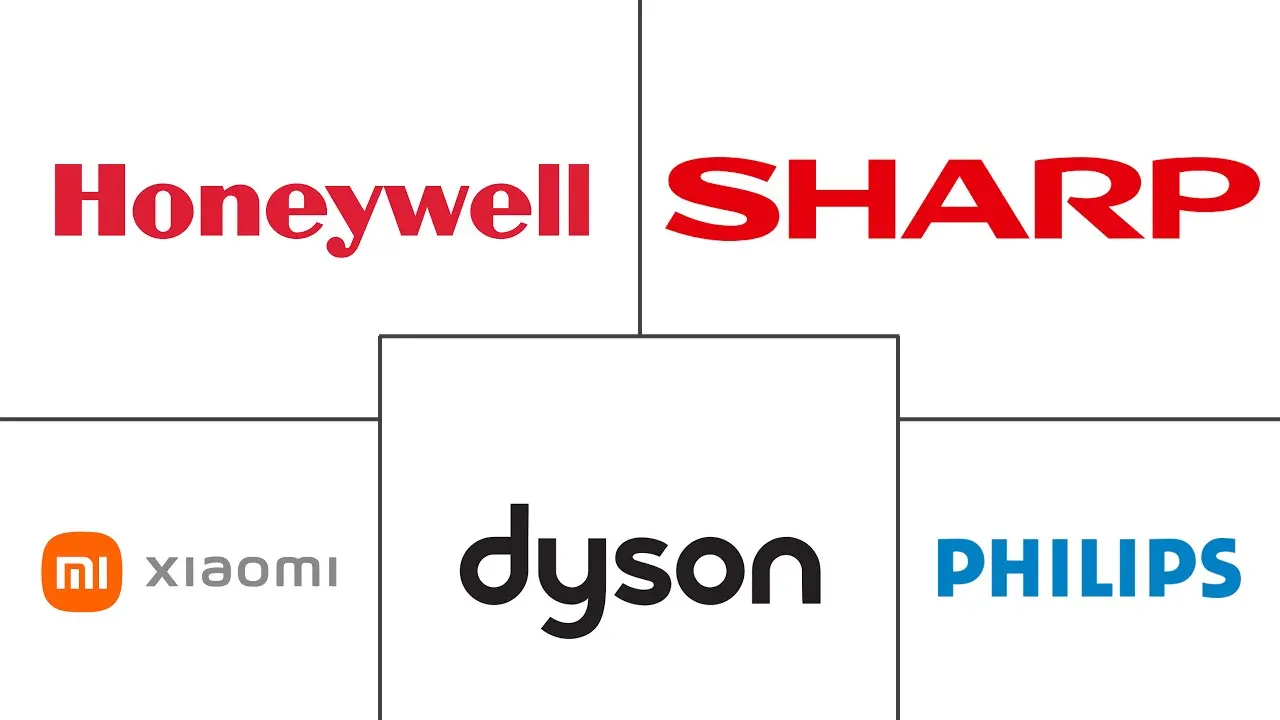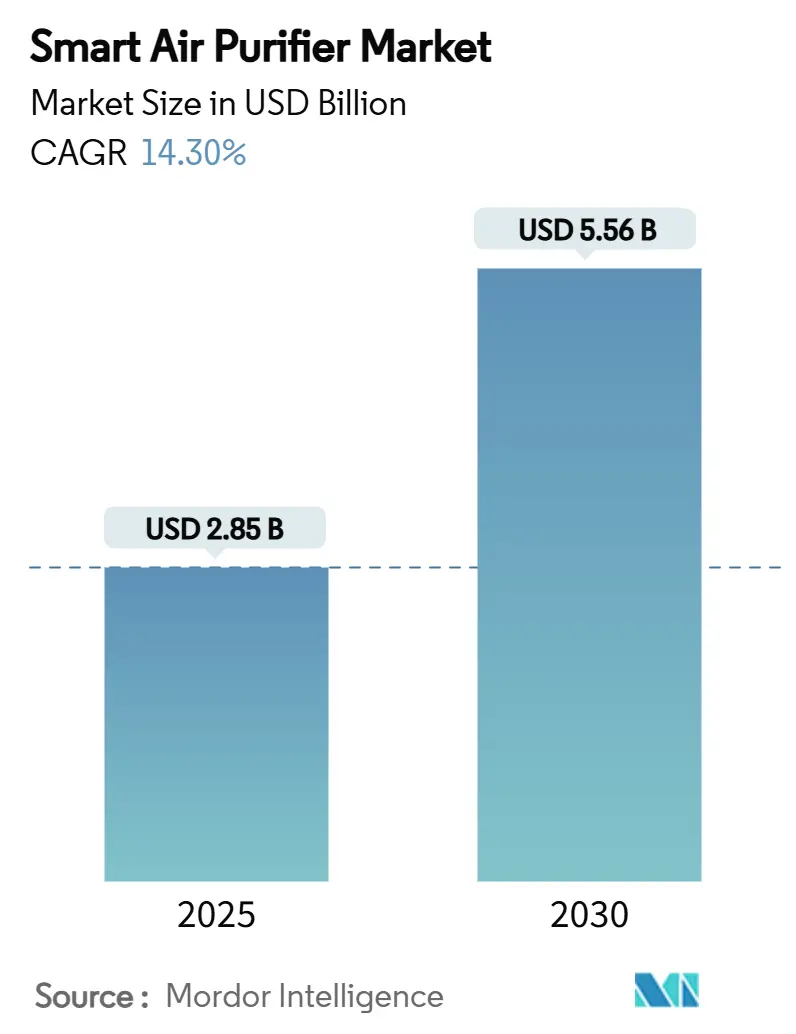
Smart Air Purifier Market Analysis by Mordor Intelligence
The smart air purifier market stood at USD 2.85 billion in 2025 and will reach USD 5.56 billion by 2030, advancing at a 14.3% CAGR. Stricter particulate-matter limits in the United States, mandatory energy caps for networked air cleaners in Europe, and rising PM2.5 awareness in Asia underpin that outlook[1]U.S. Environmental Protection Agency, “National Ambient Air Quality Standards for Particulate Matter,” epa.gov. Lower sensor costs, stronger IoT ecosystems, and multi-stage filtration upgrades are moving the category from passive appliances to connected wellness devices. Commercial real estate owners now view indoor-air quality data as a tenant-retention lever, while insurers pilot premium discounts for homes that share verified air-quality readings. Energy-efficient ionic and electrostatic designs are gaining ground as buyers look to cut filter replacement costs without sacrificing performance. Competitive intensity remains high because large electronics companies, HVAC firms, and niche start-ups all see room to differentiate through patented sensing, AI-based airflow control, and platform integrations.
Key Report Takeaways
- By product type, dust collectors led with 45% of the smart air purifier market share in 2024; fume and smoke collectors are projected to rise at a 15.2% CAGR through 2030.
- By technology, HEPA systems commanded 60% revenue share of the smart air purifier market in 2024, while ionic filters are on track for a 17% CAGR to 2030.
- By installation type, stand-alone portable units accounted for 63% of the smart air purifier market size in 2024, whereas in-duct central HVAC systems will expand at a 15.1% CAGR to 2030.
- By application, residential settings held 55% of the smart air purifier market revenue in 2024, yet commercial deployments carry the highest forecast CAGR at 16.3% to 2030.
- By distribution channel, online channels within B2C retail command 40% market share in 2024 and are growing at 17.5% CAGR through 2030.
- By geography, Europe contributed 32% revenue in 2024, and Asia-Pacific is set to post the fastest 14.4% CAGR through 2030.
Global Smart Air Purifier Market Trends and Insights
Drivers Impact Analysis
| Driver | (~) % Impact on CAGR Forecast | Geographic Relevance | Impact Timeline |
|---|---|---|---|
| Rising urban PM2.5 & VOC awareness | +2.9% | Global, concentrated in APAC urban centers | Medium term (2–4 years) |
| Integration with smart-home ecosystems & voice assistants | +2.2% | North America & Europe, expanding to APAC | Short term (≤ 2 years) |
| Stricter indoor-air-quality regulations in key economies | +3.4% | North America & Europe, spillover to MEA | Long term (≥ 4 years) |
| Post-pandemic consumer spend on residential wellness | +2.0% | Global, strongest in developed markets | Medium term (2–4 years) |
| Falling sensor costs enabling embedded IAQ modules | +2.5% | Global manufacturing hubs, cost benefits worldwide | Short term (≤ 2 years) |
| Insurance premium discounts tied to IAQ data | +1.5% | North America & Europe pilot programs | Long term (≥ 4 years) |
| Source: Mordor Intelligence | |||
Rising Urban PM2.5 & VOC Awareness
Urban air quality deterioration has reached crisis levels in major metropolitan areas, and severe smog episodes in Ho Chi Minh City and Delhi, India, turned inland air pollution into front-page news in 2025. Real-time particulate sensors inside connected purifiers translate invisible hazards into easy-to-read dashboards, raising purchase urgency among city dwellers. Users also link pollutant spikes to specific cooking or cleaning activities, creating behaviour change that further underscores device value. Manufacturers now promote 0.3-micron detection and VOC correlation as proof points rather than optional add-ons. As a result, the smart air purifier market benefits from health-driven demand that is less price-sensitive than previous discretionary gadget cycles.
Integration With Smart-Home Ecosystems & Voice Assistants
Partnerships between HVAC controllers and air purifiers allow automated airflow boosts during peak outdoor pollution periods, improving comfort without user intervention[2]Copeland, “Sensi and Woosh Launch Unified Smart-HVAC Air Filtration,” copeland.com. Voice assistants trigger “clean air” routines that raise fan speeds and switch on UV-C modules before occupants arrive home, embedding purifiers into daily habits. Cloud dashboards consolidate air-quality, occupancy, and energy data, giving building managers actionable insights. This interoperability makes standalone models less attractive, pushing brands toward open APIs and Matter-ready firmware. The dynamic lifts repeat sales because firmware upgrades and accessory sensors extend product relevance.
Stricter Indoor-Air-Quality Regulations in Key Economies
Indoor-air rules are shifting quickly. What began as voluntary guidance is now turning into firm mandates that apply to offices, factories, and homes. Because buyers must meet these requirements, they focus less on price and more on proof of compliance, giving steady revenue to brands with certified products. The U.S. PM2.5 limit moved to 9 µg/m³ in 2024, and ASHRAE Standard 241 linked pathogen control to “Equivalent Clean Airflow” targets. The European Union then capped networked purifier standby power below 0.50 W[3]European Commission, “Commission Regulation 2023/826 on Ecodesign for Air Cleaners,” europa.eu. Such mandates turn air-purifier installations into quasi-compliance buys across offices, schools, and healthcare sites. Manufacturers that certify units under multiple regional standards reduce procurement friction, enabling price premiums and higher contract win rates. Over time, regulatory stringency incentivizes higher-end sensor suites, reinforcing the smart air purifier market’s value proposition.
Falling Sensor Costs Enabling Embedded IAQ Modules
Low-cost chips and large-scale production now put advanced air-quality sensors within reach of everyday products. Makers can fit several sensor types—PM2.5, PM10, VOC, formaldehyde, and CO₂—onto a single, compact board that slips easily into smart speakers, thermostats, or air purifiers. Falling IoT-module prices let brands add cloud dashboards and remote alerts without driving up hardware costs. As a result, real-time air-quality readings will soon be common even in entry-level devices, while premium models will stand out through richer software, predictive analytics, and subscription services that keep users engaged long after purchase. Lower BOM (Bill of Materials) costs also encourage OEM partnerships in ceiling fans, dehumidifiers, and HVAC vents, embedding purification into adjacent appliances and widening total addressable demand for the smart air purifier market.
Restraints Impact Analysis
| Restraint | (~) % Impact on CAGR Forecast | Geographic Relevance | Impact Timeline |
|---|---|---|---|
| High device & filter-replacement costs | −2.8% | Global, particularly price-sensitive emerging markets | Medium term (2–4 years) |
| Consumer skepticism over performance claims | −1.9% | Developed markets with high media literacy | Short term (≤ 2 years) |
| Data-privacy & cyber-security risks in connected units | −1.3% | Global, strongest in privacy-conscious regions | Long term (≥ 4 years) |
| Regulatory crack-downs on ozone-emitting devices | −1.0% | North America & Europe regulatory jurisdictions | Medium term (2–4 years) |
| Source: Mordor Intelligence | |||
High Device & Filter-Replacement Costs
Annual HEPA cartridge spend of USD 50–150 per unit deters lower-income households even in cities with hazardous smog [4]National Research Council of Science and Technology, “Electrostatic Air-Purification System Eliminates Filter Costs,” nrf.re.kr. Manufacturers respond with electrostatic or washable filters, but convincing buyers of comparable efficacy requires third-party validation and marketing outlays. In regions where disposable income lags pollution intensity, subsidies or pay-as-you-clean models could unlock latent demand. Until cost barriers ease, price elasticity will curb penetration, especially in multi-device scenarios such as large apartments or classrooms.
Consumer Scepticism Over Performance Claims
Independent lab tests continue to reveal gaps between advertised CADR (Clean Air Delivery Rate) values and real-world room coverage, eroding trust. Media reports on ozone-emitting ionizers add to the perception that some “smart” features mask underpowered filtration. Brands now invest in transparent AQI readouts and certification badges from recognized bodies to regain credibility. Robust data privacy policies also matter because buyers worry that cloud-linked purifiers collect personal health information. Clear disclosures and opt-in analytics help mitigate these concerns and sustain the smart air purifier market’s growth trajectory.
Segment Analysis
By Product Type: Dust Collectors Hold the Lion’s Share
Dust collectors generated 45% of the market air purifier revenue in 2024, highlighting their broad appeal for PM2.5 and allergen capture in homes and small offices. Their dominance rests on mature HEPA media and competitive pricing that suits first-time buyers. Fume and smoke collectors, however, are climbing at a 15.2% CAGR as restaurants, commercial kitchens, and light-manufacturing sites target VOCs and grease vapors. Multi-stage designs now blend particulate, activated-carbon, and catalytic layers, reducing the need for separate units. This convergence signals that future models will unify dust and fume control to streamline maintenance. The “Others” niche—pathogen detection pods and biofiltration towers—remains small but influential by pushing sensor innovation that later filters into mainstream lines. Combined, these trends keep the smart air purifier market in a state of product-type evolution responsive to emerging pollutant profiles.
Second-generation dust collectors pair 0.3-micron sensors with smartphone alerts that prompt pre-emptive fan speed increases. Fume and smoke units integrate temperature-resistant housings and grease-collection trays to suit cooking environments. Early adopters validate ROI through lower odor complaints and regulatory compliance certificates, encouraging wider industry uptake. As PM2.5 and VOC standards tighten, the total addressable smart air purifier market size for mixed-use devices will broaden further, stimulating cross-category R&D investment.
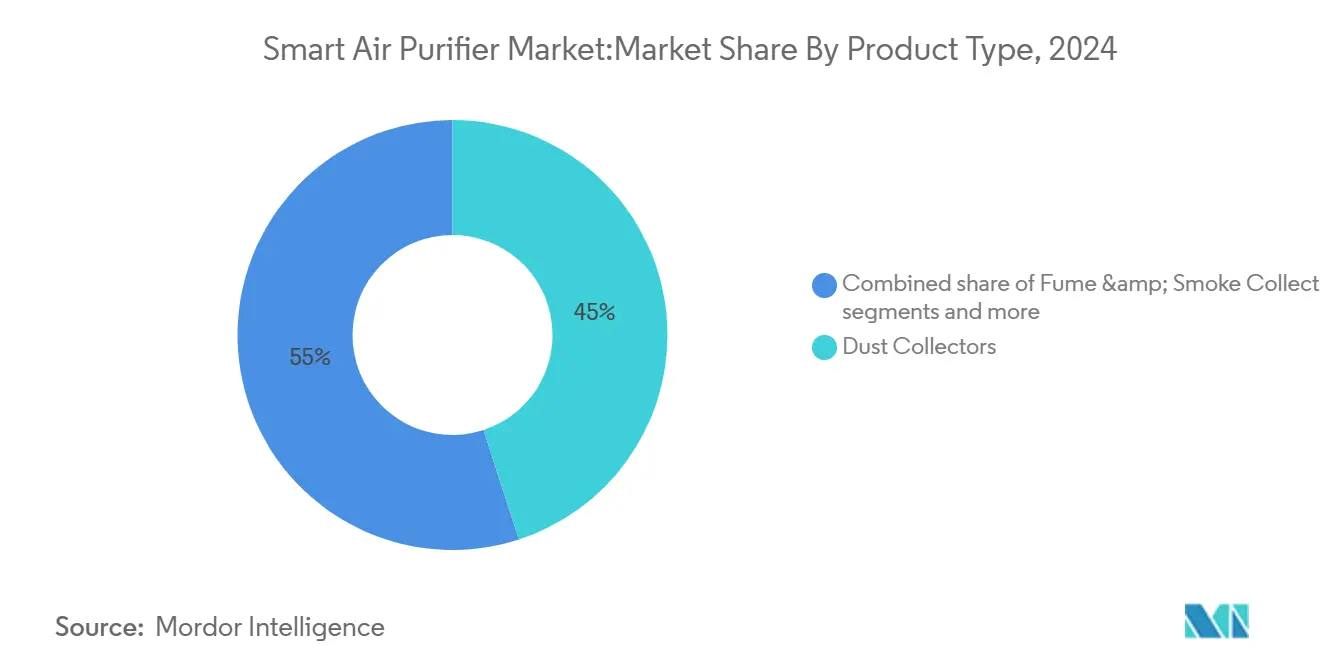
Note: Segment shares of all individual segments available upon report purchase
By Technology: HEPA Retains a Performance Edge
HEPA systems captured 60% of 2024 revenue thanks to proven 99.97% removal efficiency and strong alignment with regulatory test methods. Manufacturers now encase HEPA filters within fully sealed housings to prevent bypass and market the upgrade as “true” or “medical-grade.” Ionic filters, recording a 17% CAGR through 2030, address consumer desire for lower energy draw and filter-free operation. Their trajectory is strongest in markets where electricity tariffs are high. UV-C, activated-carbon, and plasma modules round out the technology mix, often combined in hybrid stacks to attack pathogens and odors.
Ionic solutions must manage ozone output below regional limits; firms advertise compliance certificates to reassure buyers. UV-C add-ons ride post-pandemic interest in germicidal capabilities, yet lamp-replacement cycles add cost. Start-ups explore photocatalytic oxidation and cold-plasma arrays that promise broad-spectrum pollutant breakdown with minimal consumables. This experimentation underscores a wider shift in the smart air purifier market toward modular platforms, letting users swap or layer technologies as pollutant profiles change.
By Installation Type: Portables Dominate but Central Systems Gain Speed
Stand-alone units held 63% of the smart air purifier market in 2024 because renters and homeowners value plug-and-play convenience. Lightweight towers and tabletop designs target bedrooms, nurseries, and home offices, where localized purification yields quick perceived benefits. Central HVAC-integrated systems, growing at 15.1% CAGR, bundle filtration into existing ducts for whole-building coverage. Adoption accelerates in new construction that must meet stricter green-building certifications.
Hybrid scenarios emerge in schools and hospitals, where central systems provide baseline filtration while portable units handle high-risk zones. Smart-platform compatibility enables coordinated airflow, avoiding energy waste from redundant operation. Builders specify central systems during design to minimize retrofitting costs, while brands pitch future-proof firmware that can update to comply with new standards. These factors extend the smart air purifier market’s reach into professional mechanical-ventilation channels historically served by traditional HVAC firms.
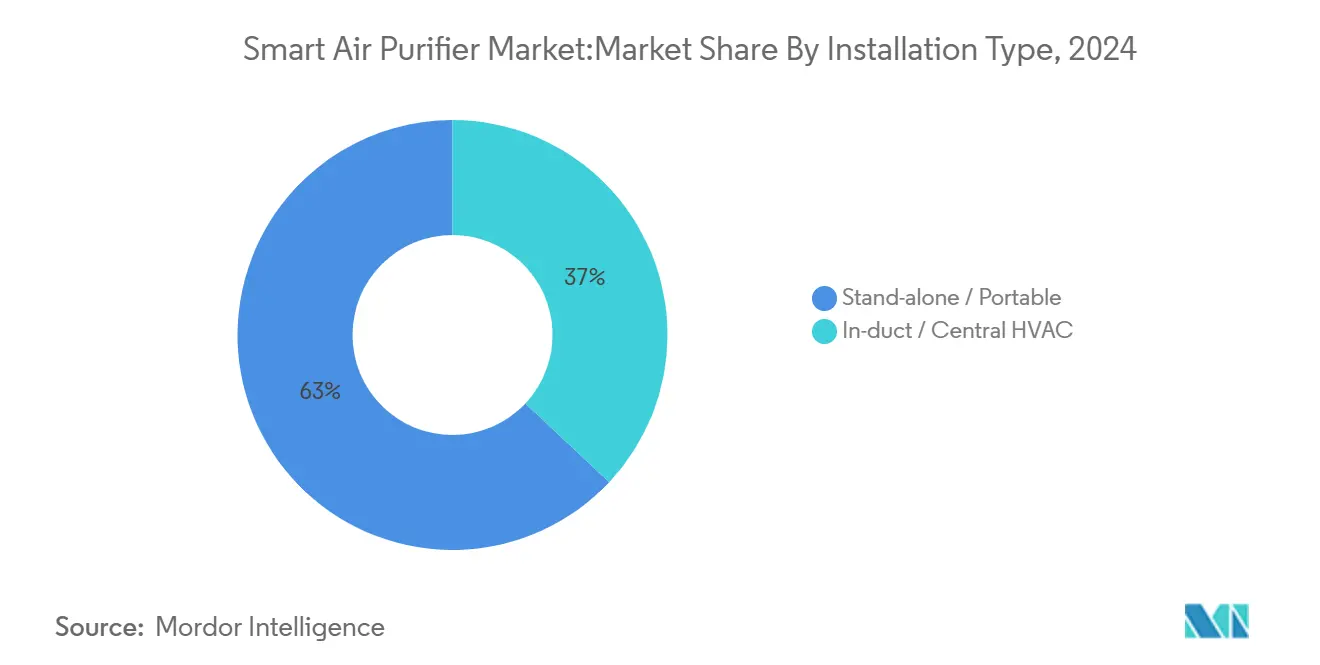
By Application: Commercial Spaces Challenge Residential Pre-eminence
Residential accounts for 55% of 2024 demand, sustained by DIY installation and health-focused marketing campaigns that speak directly to household decision makers. Commercial installations, however, expand at a 16.3% CAGR as employers tie clean-air initiatives to productivity gains and talent-retention metrics. Open-plan offices deploy networked purifiers that sync with desk-booking apps, improving air changes per occupancy threshold. Retailers add visible AQI displays next to checkouts to reassure shoppers, turning air quality into a differentiator.
Industrial settings adopt high-capacity units tailored for particulate-laden production zones, though longer procurement cycles temper annual growth rates. Hospitals explore pathogen-oriented filters plus UV-C sterilization to meet infection-control targets. Each application vertical prioritizes different KPIs yet converges on the need for validated data streams. This alignment reinforces the smart air purifier market’s shift from single-purpose appliances to integrated environmental-quality nodes.
By Distribution Channel: B2C Retail Leads an Omnichannel Playbook
B2C retail contributed 60% of the total 2024 sales, with big-box stores supplying instant product availability and live demonstrations. Within that, the online channel logged a 17.5% CAGR as consumers trust online reviews and appreciate home delivery of bulky devices. Exclusive brand outlets are located in experiential showrooms where visitors can see live AQI-change demos. B2B channels remain vital for large-scale commercial contracts that require site assessments and maintenance plans.
Manufacturers pursue an omnichannel mix to lower acquisition costs and reduce dependency on any single route. Online configurators capture lead data, while in-store kiosks let shoppers scan QR codes for extended specs, bridging physical and digital touchpoints. Subscription filter bundles anchor customer lifetime value, reinforcing retention. These tactics keep the smart air purifier market responsive to fast-evolving consumer research and buying behaviors.
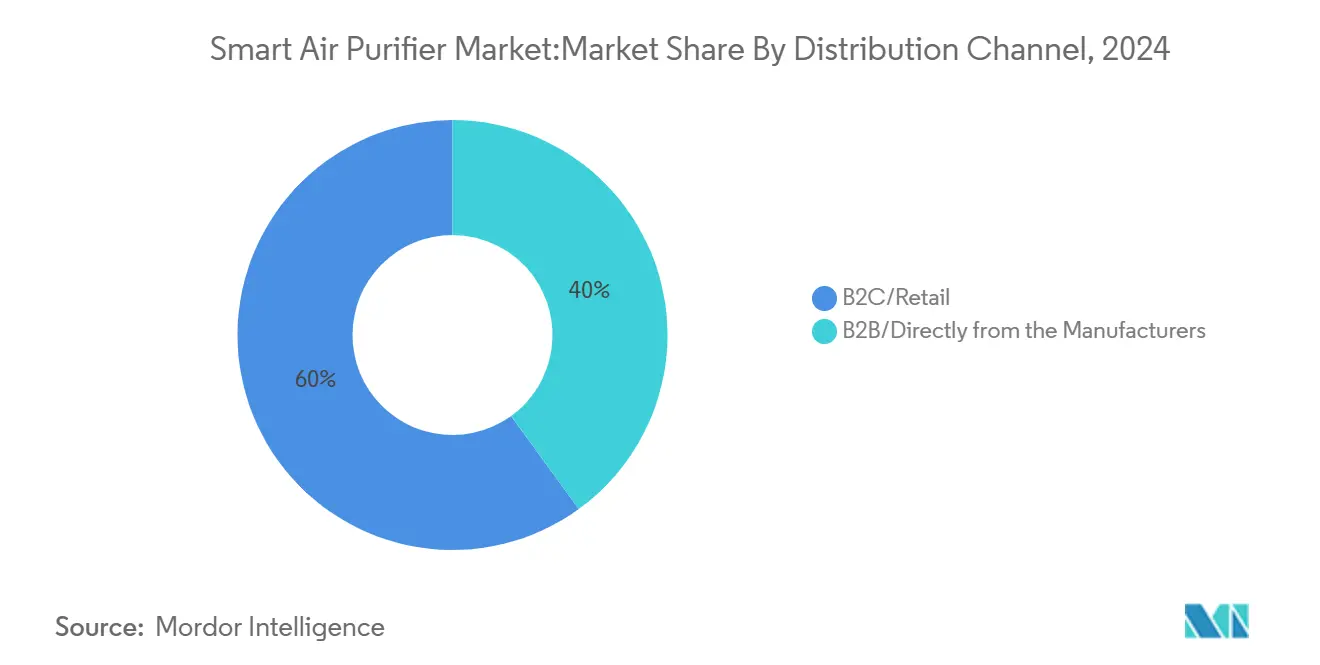
Note: Segment shares of all individual segments available upon report purchase
Geography Analysis
Europe generated 32% of 2024 revenue as ecodesign directives and consumer eco-labels spurred early adoption of energy-efficient purifiers. The region’s retailers position indoor-air quality alongside wellness categories, making upselling easier. Growth continues as commercial landlords invest in air-quality upgrades to meet green-lease clauses. Manufacturers with multilingual firmware and GDPR-compliant data policies gain trust and repeat sales.
Asia-Pacific is the fastest-growing region with a forecast 14.4% CAGR, underpinned by urbanization and high ambient smog. China’s national indoor-air monitoring expansion widens public awareness, while Indian consumers view clean-air devices as status symbols. Rising disposable income supports premium purchases, and local brands compete on localized UI and after-sales networks. Government subsidies for IoT air-quality nodes in South Korea and Japan further boost uptake.
North America shows steady, regulation-driven demand. The tightened PM2.5 limit accelerates the replacement of legacy units unable to meet new benchmarks. Smart-home penetration also favors connected purifiers that sync with existing hubs.
The Middle East and Africa present nascent yet promising opportunities. Dubai’s USD 500 million Air Quality Strategy positions clean-air appliances as part of national climate-tech portfolios. Saudi Arabia’s monitoring push across 7,000 plants indicates future compliance-led demand. South America remains early stage, but worsening urban smog in São Paulo and Bogotá hints at long-term potential once income levels rise. Overall, regulatory progress and economic development together shape the smart air purifier market’s geographic rollout path.
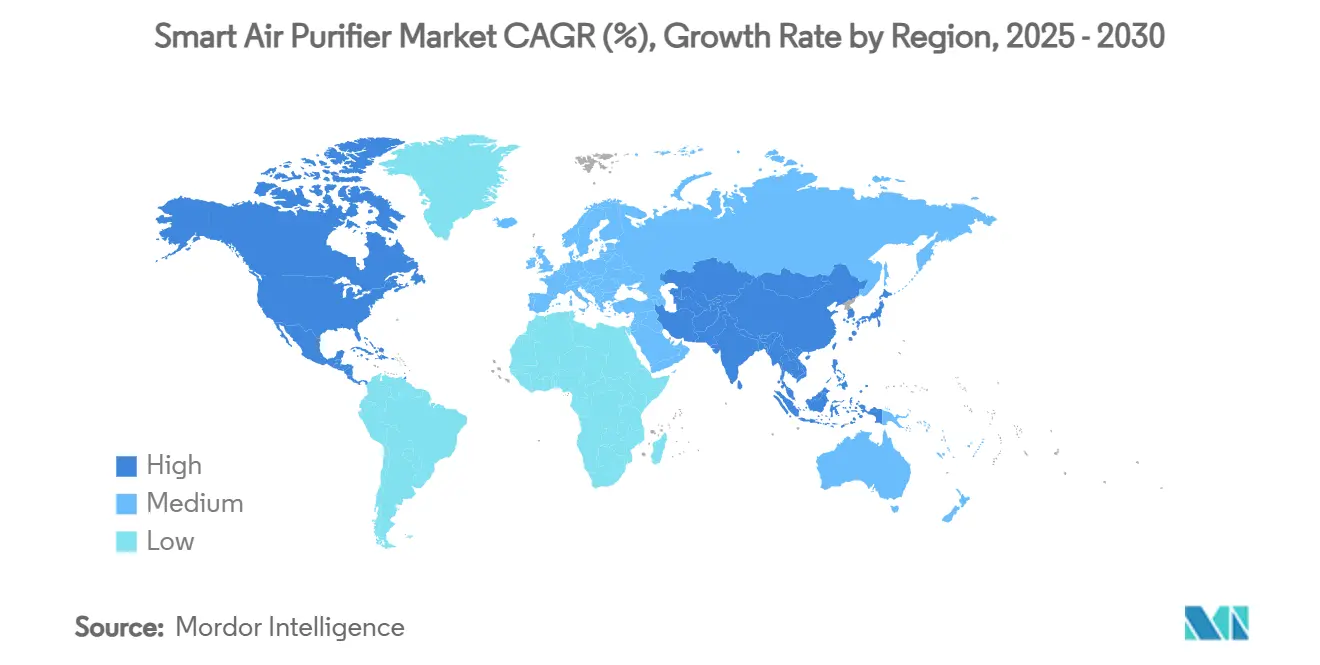
Competitive Landscape
The smart air purifier market is moderately fragmented. Dyson, Xiaomi, and Honeywell anchor the premium, value, and commercial sub-segments, respectively. Dyson leverages solid-state formaldehyde sensors and 20% noise-reduction designs to justify high price points.
Xiaomi bundles purifiers with its IoT platform, undercutting rivals on price while driving ecosystem lock-in. Honeywell emphasizes compliance with ASHRAE filtration ratings, aiming at offices and schools facing regulatory audits. Korean researchers demonstrated filter-free electrostatic units that remove 99.5% ultrafine particles and slash ownership costs. These innovations push incumbents to accelerate R&D and patent filings, particularly around low-maintenance filters and AI-driven airflow optimization.
Strategic moves gravitate toward platform partnerships. LG’s PuriCare AeroBooster syncs with the ThinQ app, while Samsung extends SmartThings support to its purifier range. Copeland’s tie-up with Woosh shows HVAC makers embedding filtration to raise system value. Subscription models for replacement filters and cloud analytics foster predictable revenue and strengthen customer retention. Over the next five years, winning firms will pair validated filtration with seamless data-sharing, recognizing that hardware alone no longer suffices.
Smart Air Purifier Industry Leaders
-
Dyson Ltd.
-
Sharp Corporation
-
Xiaomi Corporation
-
Honeywell International Inc.
-
Koninklijke Philips N.V.
- *Disclaimer: Major Players sorted in no particular order
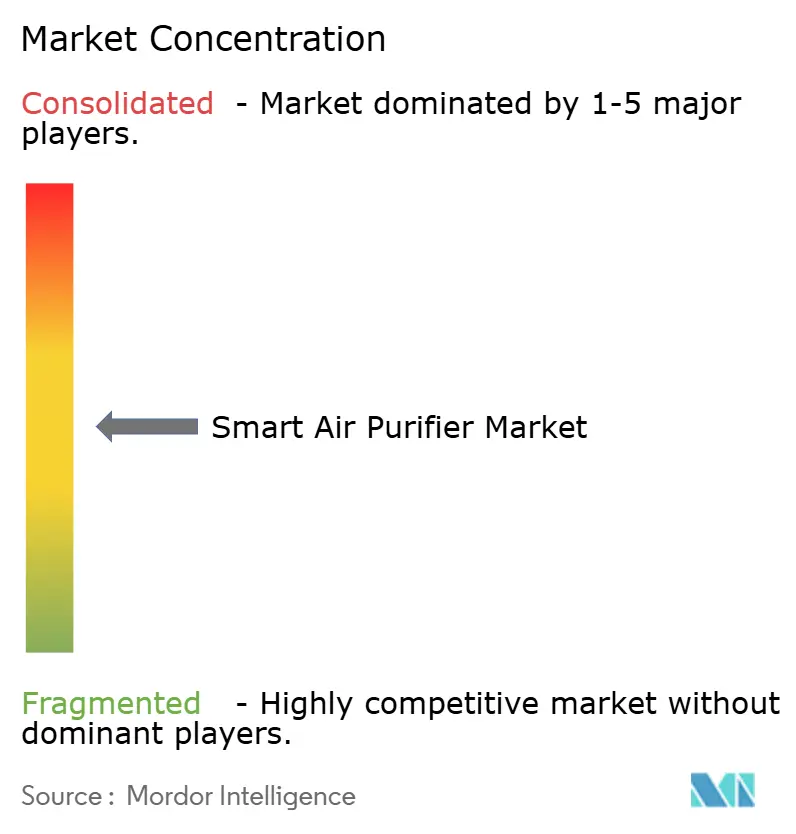
Recent Industry Developments
- March 2025: Korea Institute of Machinery and Materials deployed filter-free electrostatic technology, achieving 99.5% ultrafine-particle removal in public venues.
- January 2025: LG Electronics introduced PuriCare AeroBooster featuring Plasmaster Ionizer++ pathogen neutralization.
- January 2025: Levoit unveiled connected wellness purifiers at CES 2025.
- June 2024: Alliance Air earmarked USD 121 million for a new Tijuana plant to scale HVAC and air-purification capacity.
Global Smart Air Purifier Market Report Scope
A smart air purifier is an advanced version of a standard air purifier that is used for automatic air purification across multiple end users. It is linked to wireless networks such as Bluetooth and Wi-Fi and can be controlled remotely via a smartphone app. The global smart air purifier market report focuses on the market dynamics, trends, and demand for smart air purifiers in the market. The report offers an in-depth analysis of the key trends, segments, opportunities, and factors that are driving the market. Additionally, the key profiles of the major players in the global market are provided in detail.
Global Smart Air Purifier Market is Segmented by Type (Dust Collectors, Fume & Smoke Collectors, and Others), Technology (HEPA, Activated Carbon Filtration, and Others), Application (Residential, Commercial, and Others), Distribution Channel (Supermarkets/Hypermarkets, Specialty Stores, Online, and Other Distribution Channels), and Geography (North America, Europe, Asia-Pacific, South America, and Middle-East and Africa). The market sizes and forecasts are provided in terms of value (USD billion) for all the above segments.
| Dust Collectors |
| Fume & Smoke Collectors |
| Others |
| HEPA |
| Activated Carbon Filtration |
| Ionic Filter |
| Ultra-Violet Technology |
| Others |
| Stand-alone / Portable |
| In-duct / Central HVAC |
| Residential |
| Commercial |
| Industrial |
| B2C/Retail | Multi-brand Stores |
| Exclusive Brand Outlets | |
| Online | |
| Other Distribution Channels | |
| B2B/Directly from the Manufacturers |
| North America | Canada |
| United States | |
| Mexico | |
| South America | Brazil |
| Peru | |
| Chile | |
| Argentina | |
| Rest of South America | |
| Europe | United Kingdom |
| Germany | |
| France | |
| Spain | |
| Italy | |
| BENELUX (Belgium, Netherlands, and Luxembourg) | |
| NORDICS (Denmark, Finland, Iceland, Norway, and Sweden) | |
| Rest of Europe | |
| Aisa-Pacific | India |
| China | |
| Japan | |
| Australia | |
| South Korea | |
| South East Asia (Singapore, Malaysia, Thailand, Indonesia, Vietnam, and Philippines) | |
| Rest of Asia-Pacific | |
| Middle East And Africa | United Arab of Emirates |
| Saudi Arabia | |
| South Africa | |
| Nigeria | |
| Rest of Middle East And Africa |
| By Product Type | Dust Collectors | |
| Fume & Smoke Collectors | ||
| Others | ||
| By Technology | HEPA | |
| Activated Carbon Filtration | ||
| Ionic Filter | ||
| Ultra-Violet Technology | ||
| Others | ||
| By Installation Type | Stand-alone / Portable | |
| In-duct / Central HVAC | ||
| By Application | Residential | |
| Commercial | ||
| Industrial | ||
| By Distribution Channel | B2C/Retail | Multi-brand Stores |
| Exclusive Brand Outlets | ||
| Online | ||
| Other Distribution Channels | ||
| B2B/Directly from the Manufacturers | ||
| By Geography | North America | Canada |
| United States | ||
| Mexico | ||
| South America | Brazil | |
| Peru | ||
| Chile | ||
| Argentina | ||
| Rest of South America | ||
| Europe | United Kingdom | |
| Germany | ||
| France | ||
| Spain | ||
| Italy | ||
| BENELUX (Belgium, Netherlands, and Luxembourg) | ||
| NORDICS (Denmark, Finland, Iceland, Norway, and Sweden) | ||
| Rest of Europe | ||
| Aisa-Pacific | India | |
| China | ||
| Japan | ||
| Australia | ||
| South Korea | ||
| South East Asia (Singapore, Malaysia, Thailand, Indonesia, Vietnam, and Philippines) | ||
| Rest of Asia-Pacific | ||
| Middle East And Africa | United Arab of Emirates | |
| Saudi Arabia | ||
| South Africa | ||
| Nigeria | ||
| Rest of Middle East And Africa | ||
Key Questions Answered in the Report
What is the current size of the smart air purifier market?
The smart air purifier market was valued at USD 2.85 billion in 2025 and is projected to reach USD 5.56 billion by 2030.
Which region holds the largest revenue share?
Europe leads with 32% of 2024 revenue due to stringent energy and ecodesign regulations.
Which technology leads today’s installations?
HEPA filtration accounts for 60% of 2024 revenue because of its proven particulate-removal efficiency.
Where is the fastest growth expected?
Asia-Pacific is forecast to grow at a 14.4% CAGR to 2030, driven by urbanization and rising air-quality awareness.
Are commercial or residential buyers driving future demand?
Commercial deployments are advancing the fastest, with a 16.3% CAGR expected as offices, schools, and retail sites prioritize indoor-air metrics.
How will regulations influence product design?
Tougher PM2.5 limits and energy caps are pushing manufacturers to integrate higher-accuracy sensors and lower-standby-power electronics into next-generation models.
Page last updated on:
